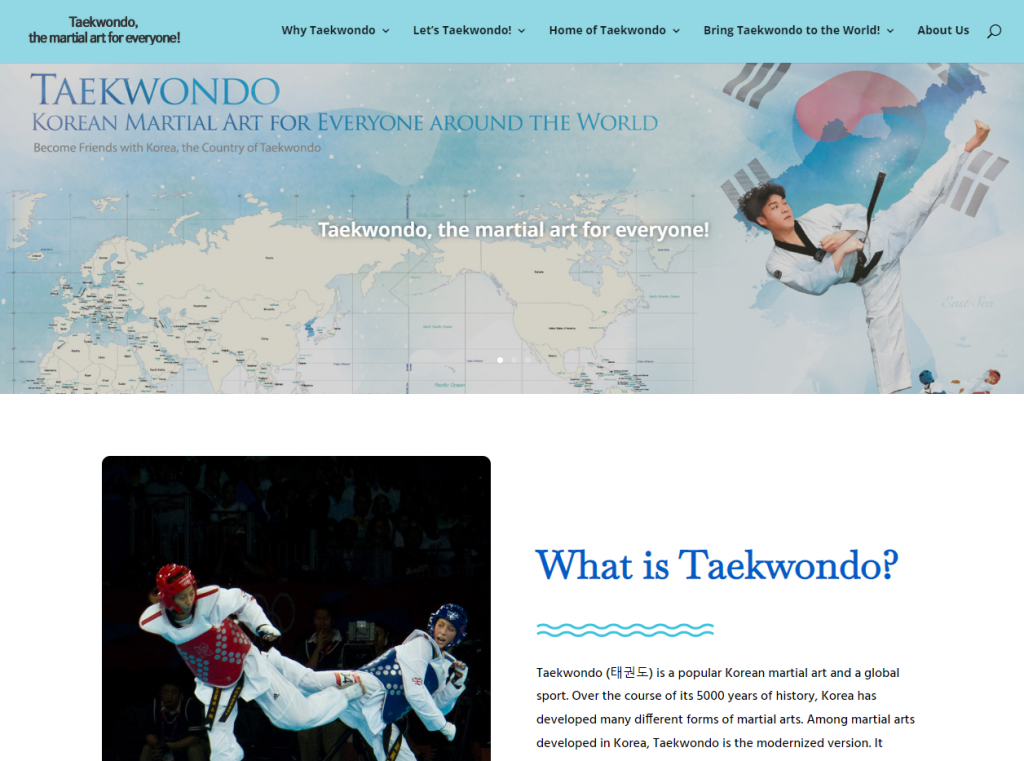There is a high chance that you’ve come across Taekwondo at least once, whether it was during a random TV channel switch during the Olympics season or the news of a new Taekwondo kwan (training center) built near your residence. Maybe, you are a Taekwondo trainee yourself.
Taekwondo is a Korean martial art that focuses on using both fists and kicks in its attack. It has many physical benefits including increased flexibility, strength, and cardiopulmonary function. However, Taekwondo not only improves your body but also strengthens your mind. Teachings of Taekwondo include the process of meditation and insights about self-restraint and manners. One of the first lessons starts with learning a proper respectful greeting toward teachers and elders. Abusing Taekwondo skills is a great taboo in Taekwondo. If one wrongfully uses Taekwondo in malicious ways including crimes, one’s Taekwondo license and rank can be revoked. Although an effective self-defense martial art, Taekwondo emphasizes being kind and protective to the weak and never misusing physical strength gained through Taekwondo training.
Where did these values of Taekwondo come from? There are many theories for the roots of Taekwondo. Taekwondo is a relatively modern martial art composed of several movements from different small martial arts that were prevalent throughout Korea. When we trace the root of Taekwondo to martial arts that do not use any weapons, we eventually arrive at martial arts practiced by hwarang of the Silla Kingdom (around 18 BC ~ 936 AD.)
Hwarangdo, the disciplines, and duties followed by hwarang (corps of youth warriors) are regarded as one of the important factors that enabled the Silla Kingdom to unite all kingdoms and end the three-kingdom era. The hwarangdo spirit valued loyalty, filial piety, and reliability. They incorporated religious worship into their philosophy to strengthen patriotism and followed disciplines including modesty, frugality, and restraint. Hwarangdo spirit also honored ethics and not committing any faults. Modern Taekwondo philosophy adopts the theory of spiritual energy. There are many philosophical theories suggested by various philosophers, but all highlight righteousness and self-restraint as the core of the Taekwondo spirit.

Taekwondo is now a culture deeply incorporated into daily life in Korea. In Korea, many children enroll in Taekwondo kwan as an extracurricular activity. Through Taekwondo, they let out their immense youthful energy and socialize with other children as fellow trainees. Taekwondo kwan also serves as a place where children can learn respect and manners toward elders while earning a sense of accomplishment when they successfully complete lessons. Some Korean schools even adopt Taekwondo as a part of their physical education curriculum (This included my school where I earned my first Taekwondo black belt as an advanced exam.) There is at least one Taekwondo kwan near a residential area with children wearing dobok (Taekwondo uniform) gathering around for their training.
Taekwondo’s popularity is not limited to the Korean peninsula. Many Taekwondo kwans are present across the world thanks to many Taekwondo masters immigrating to foreign countries and continuing their teachings. In 1988, Taekwondo became an Olympic sport with various local and global annual Taekwondo competitions being held in many countries. Taekwondo is also a popular martial art for parents to have their children learn. However, many people do not recognize Taekwondo beyond its definition as one of many martial arts that exist in the world.

To help people to learn more about Taekwondo, VANK created an English promotional website ‘Taekwondo, the martial art for everyone!’ (https://taekwondo.prkorea.com/). The purpose of the website is to advertise the benefits of Taekwondo and how Taekwondo’s treasured values relate to the innate ideas of Korea. The website is also the extension of VANK’s campaign that aims to make Taekwondo an official PE subject around the world and transform Taekwondo kwan into a place promoting Korean culture and history. Last year, VANK printed around 8,000 Taekwondo-theme world maps and supplied them to international Taekwondo volunteers to distribute to Taekwondo kwans across the world.

Taekwondo is a perfect martial art for not only the growth of the body but also the growth of the mind. Now, it aims to serve as a perfect start for Korean history and culture promotion. If you are starting to or learning Taekwondo, think about Korea, the country where Taekwondo comes from, and its brilliant history and culture that made the righteous Taekwondo philosophy to be born.
Written by: Gain Hahn
